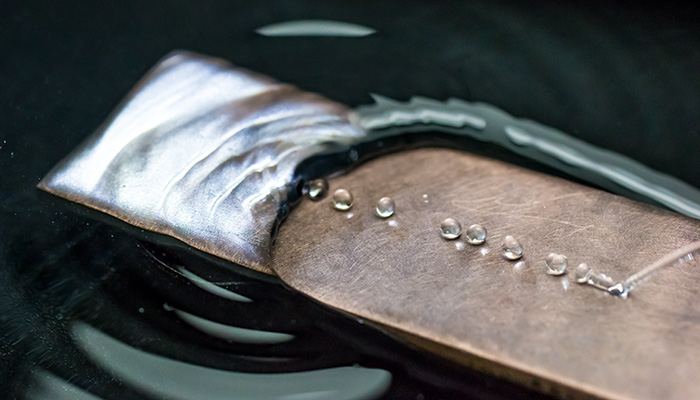
Soft Matter and Wetting research group at Aalto University published insights about superhydrophobic surfaces in Science recently [1]. The non-wetting surfaces have experienced an enormous boost of interest after the observation of superhydrophobicity and self-cleaning effect in natural lotus leaves
Research interest has grown exponentially since the late 1990s due to its tremendous application potential in areas such as self-cleaning, anti-icing, drag reduction and enhanced heat transfer.
By a common definition, a surface is considered superhydrophobic if the water contact angle is larger than 150° and if the water droplets readily slide off the surface.
How to characterize wettability on superhydropic surfaces?
Authors call for standardized testing for these novel surfaces as the lack of standardization usually makes comparison of different reported results impossible. They pointed out that variety of methods have been used to test the durability of superhydrophobic surfaces, including linear abrasion, circular abrasion, tape peeling, blade scratching, sand abrasion, ball-on-disk sliding, oscillating steel ball, and water jet tests. An additional issue is that surface wetting is often not characterized in the most useful manner. Wetting characterization was recommended to include both droplet mobility and the advancing and receding contact angles (Dynamic contact angle analysis). Authors did not recommend to use the static contact angle as it is not easily affected by abrasion. It is imperative to characterize the effect of wear in terms of change in contact angle hysteresis i.e. difference between advancing and receiving angles, or just in the receding contact angle. Alternatively, the sliding or roll-off angle was recommended, as it is related to contact angle hysteresis.
To learn more how to study superhydrophobic surfaces, see the webinar by Prof. Robin Ras.
1. Tian X., Verho T., Ras R.H.A., Moving superhydrophobic surfaces toward real-world applications, Science 352, 142-143 (2016).
Photo: Water droplets rolling on a superhydrophobic surface. The repellency of a superhydrophobic surface immersed in water causes a depression in the water, and the surface under water has a silvery shine caused by a microscopic layer of air trapped between the water and the superhydrophobic surface. Photo by Mika Latikka, Aalto University.
Discover why contact angle is essential for adhesion, coatings, and quality control. Learn how surface wettability impacts product performance.
Discover why PFAS-free coatings are needed, the challenges they present, and key strategies for developing high-performance alternatives.
At the heart of droplet formation are two key molecular forces: cohesion and adhesion.
Contact angle measurements provide a golden standard for evaluation of surface properties for quality control.
Contact angle is the angle a droplet forms in contact with a solid surface. Thermodynamically, it is a balance between cohesive and adhesive forces.
This blog post discusses the importance of adhesion in the lithography process and how to predict adhesion with contact angle measurements.
HMDS is used to render the surface of silicon more hydrophobic and thus to match better with the chemistry of the photoresist.
This blog post explains the concept of RCA cleaning and it's relation to contact angle.
Contact angle measurements can be used to evaluate the cleanliness of silicon wafers.
